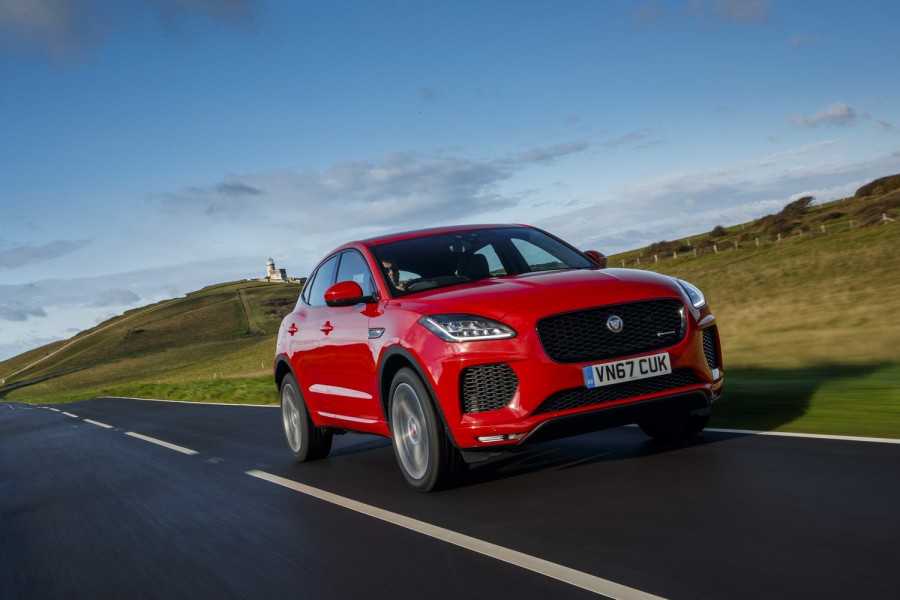Jaguar's new E-Pace SUV proves that you can mix sharp handling with some off-road ability.
In the metal
When it came to styling the new Jaguar E-Pace, it would have been easy for the design team to just scale down the F-Pace. Thankfully, Ian Callum and his team adopted a different approach, which is mostly down to how the E-Pace drives. From the outset, this was to be a fun car, one that people would enjoy driving, hence the influence from the F-Type.
Like all current Jaguars, the sizeable rounded grille plays a dominant role in the frontal design. Although, currently at least, all E-Pace models are powered by transversely-mounted Ingenium four-cylinder engines, the power bulge running along the bonnet that originally served to accommodate straight six-cylinder engines in the E-Type is a nice styling touch. The headlights are a nod to the current F-Type, and while there isn't much in the way of plastic cladding aside from the wheelarch surrounds, a cut into the lower door sections gives the impression of a chunkier body.
Despite the E-Pace being a relatively compact car, with little rear overhang, it still manages to fit in a 577-litre boot, which, with the 60/40 split folding rear seats, can grow to 1,234 litres. The cabin is spacious and in this First Edition appears very well finished. Jaguar in the past has left plastics in some areas being less than desirable, but everything here looks and feels top notch. Seating in the back is comfortable with headroom less of an issue for those of average height. It will seat three across, but for longer journeys two adults will be more comfortable.
Standard models get a simple dual instrument dial display with a TFT screen nestled in between. Optionally, a 12.3-inch digital display is available to order. All models feature Jaguar's latest 10-inch landscape touchscreen infotainment system, which is very responsive and doesn't smudge thanks to its matte finish. Beneath that is a line of small buttons for functions like the heated screens and three large rotary dials for the climate control. Tiered door bins allow you to fit plenty in and a deep storage box between the front seats offers plenty of space for smaller items along with USB charging ports.
Driving it
To create the chassis for the E-Pace, Jaguar delved into other JLR models for the best bits. The front is a modified version of that found in the Land Rover Discovery Sport, while the rear end uses the same design as the more substantial F-Pace only scaled down slightly to suit the E-Pace's body. Extensive use of boron through the sills and around the car adds a great deal of rigidity, making it not only 20 per cent stiffer than a Discovery Sport, but the second stiffest car in the range after the F-Type. And it shows.
Even within the first few kilometres of driving, the E-Pace is clearly a sporty car. Larger rear anti-roll bars and an increase in negative camber up front results in a Jaguar that turns in quickly. The active driveline all-wheel-drive transmission is tuned to deliver a rear bias, but it can distribute up to 50 per cent of power to the front axle. In certain conditions it can send 100 per cent of torque to the outside wheel when cornering and can adjust this while reading the tractions levels and driver input every ten milliseconds.
Through bends, the steering feels well-weighted, and the E-Pace reacts well to any sudden line changes. Its body stiffness is apparent in the lack of any unnecessary body roll through the corners. As SUVs go, this is one fun car to drive, but it is equally happy to potter along through town. In the latter case, it feels refined, and the turbocharged four-cylinder diesel is rarely stressed. The nine-speed automatic transmission shuffles through gears to keep the revs to a minimum and exploit the 430Nm of torque, which is available in full at 1,750rpm. Where the diesel engine loses some of its lustre is when it's pushed harder, especially when manually changing with the metal paddle shifters. Above 3,000rpm it starts to get quite loud and sounds coarse, certainly not encouraging you to extract every last rev.
In the limited amount of off-roading we did, the E-Pace breezed through, even on its 245-section 20-inch Pirelli P Zeros. If anything, it was a useful opportunity to sample the All Surface Progress Control system that takes charge of the throttle and braking inputs while off-road. Once activated, the driver has to only concentrate on steering and the speed is set by a control on the wheel, just like cruise control. It's a useful system for anyone that has no off-road experience and finds themselves in such a situation.
What you get for your money
Jaguar might be keen to point out the E-Pace's €36,000 starting price for the 150hp front-wheel-drive manual 'S' version, but even moving up just one rung to the similarly engined 'R-Dynamic Base' bumps the price up by €8,510 to €44,510. For comparison, the generously-equipped 'First Edition' model tested here costs €76,270, and that isn't even with the most powerful diesel engine. Nor does that include the 12.3-inch display, which costs a further €950.
If your driving is typically confined to urban routes, the 150hp engine should suffice, as will front-wheel drive - the latter alone will save you around €4,000. However, if you want the nine-speed automatic transmission, which is nice to have, the starting price will be €46,535. It does undercut similar models like the Land Rover Discovery Sport by €2,000 and Evoque by almost €6,000.
Summary
Rather than merely make a downsized SUV based on the F-Pace, Jaguar has turned the E-Pace into a much more involving car to drive. It remains a premium car in appearance and quality, while the variety of engines should cover most customer demands.





































































































































































